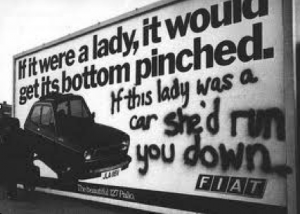baby you can drive my car: gender in car advertising
As we saw at the end of Mad Men season five (Spoiler alert!), the luxury car industry was especially sexist in the ‘60s. However, when it comes to gender and cars, not much has changed.
Technology plays a significant role in our everyday lives today, as does our gender. In fact, the two are often interwoven in complex ways. Although technology seems neutral on the surface (a car is just a car, right?), objects are developed by individuals and companies who are socially situated in a gendered world. The relationship between gender and technology can be clearly observed through the gendered discourses in car advertising.
Some cars are clearly marketed as “women’s cars” – they’re often small and easy to park, or have lots of natty little compartments to put all your make-up and other feminine junk. Then there’s “men’s cars” – they might range from four wheel drive utes with plenty of space to throw tools and cartons of beer, to luxury cars like Aston Martins for a dignified motoring enthusiast who watches Top Gear, possibly smokes a pipe and deep down wishes/thinks he’s a bit of a James Bond (Sean Connery of course, not Daniel Craig. And please god, not George Lazenby).
There are three advertisements for cars that I have seen recently that I think exemplify some of the ways we use technology as a way of “selling” gender. First, the Audi 2013 Super bowl ad, which caused controversy over its apparent endorsement of rape culture. A basic run down of the ad, titled Prom, is as follows: Young guy is a bit bummed out because he’s going to his senior high school prom with no date, and gets all emo when his mum tries to comfort him saying that ‘now days lots of people go by themselves.’ He heads for the door, when good ol’ dad throws him the keys to his BRAND NEW AUDI (yeah, right), wishing him a good time. Young dude gets all excited, pulls up at the school in the principal’s parking space, storms into the prom, hunts down the Prom Queen and forcibly kisses her in the middle of the crowd. Then her boyfriend, a big blond jock comes after him and it is implied that he punches him in the face. Then the young guy speeds away in the Audi with a black eye and a hoot of delight. Cut to tag line: ‘Bravery: It’s what defines us.’ Earlier in the year I blogged about how this ad represents cars as symbols of masculine power, strength and mobility. This ad exemplified the fact that it’s often men who project themselves into the world through phallic fetish objects like cars and weapons.
The Mazda 2 is sold as a zippy little women’s car that, like the Audi, also acts as a way of achieving mobility and autonomy. However, because it’s for women, (and it’s not a luxury car) it isn’t as glamorous. The ad features a woman struggling to reverse park in between a car and a truck flanked by burly council workers who jibe that ‘she’s never gonna get in there.’ With a sigh of exasperation, the woman speedily drives on, then reverses over the top of a plank on the back of the truck, see-sawing down deftly into the parking space. She steps out of the car and strides away with the debonair confidence of a woman in a deodorant commercial. This ad plays on the already existing stereotype of women as incapable drivers, subverting it but in an unrealistic way, giving the ad a sense of fantasy that almost reinforces the idea that women are apparently hopeless drivers.
The final ad I have seen recently that I think positions gender as central to our use and consumption of technology is the Holden Barina ad that has been all over YouTube. You’ve probably seen it, because it’s at the start of EVERY music clip I’ve tried to watch lately and it’s one of those ones you can’t skip in five…four…three…two… skip ad. The ad posits ‘can a Barina save your relationship?’ and shows a nice chap named Dave who was luckily reminded by his talking AI car (!!) that it is his and his girlfriend’s anniversary. He uses the GPS in the car to go to balloon shops, florists, lingerie stores and learn French in order to satisfy the romantic needs of his cartoonishly feminine squeeze.
But, when he gets to her house to surprise her with all of his textbook romantic finery, SHE has forgotten that it’s their anniversary. I like this ad because it turns all of the usual gender elements of car advertising on its head. What would usually be marketed as a “women’s car” is being driven around my a new-age guy to dopily buy flowers, while a young woman is blissfully unaware of the romantic milestones over which women are usually depicted as doting over more than anything else.
What can be gleaned from this brief look at three irritating, but kind of intriguing ads is that both gender and technology are integral to constructing who we are in contemporary consumer societies and whether this is a good or a bad thing is entirely up to you.



Pingback: Top 5 Features That Matter Most To Women Drivers – Top Cars for Women